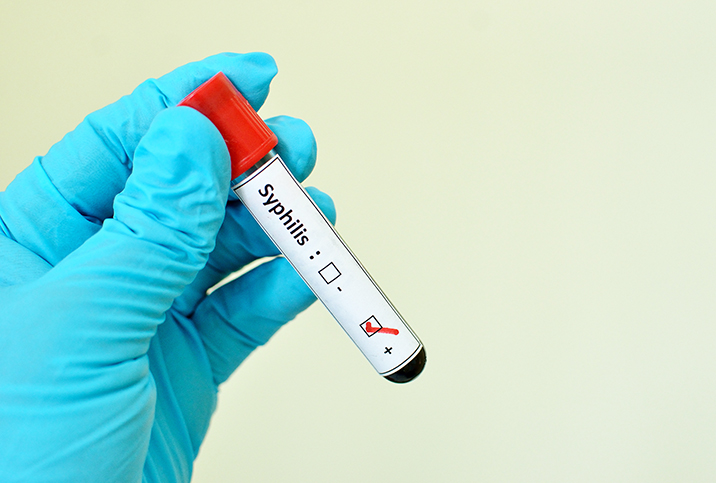Get to Know Syphilis (Before It Gets to Know You)

Classified as a sexually transmitted disease (STD), syphilis is a bacterial infection that is easy to cure, but it can pose serious complications if left untreated. Though syphilis is often associated with visible sores, many people don't realize it can be inactive or dormant in the body for years. Because it can be difficult to know if you have contracted syphilis, STD testing is imperative if you are sexually active.
Transmission
The most common syphilis transmissions occur when a person's genitals or mouth touch the syphilis sores of an infected person. This usually happens during sexual contact. It is less common to contract syphilis during oral sex, but it is still possible.
Syphilis lives on the skin and mucous membranes. The infection typically begins as a sore on the genitals, mouth or rectum, and can eventually develop into a rash. Without treatment, syphilis can cause organ damage, which can be fatal. Syphilis can go undetected for a long time, and the infection can be spread even if the person has no symptoms. It can also be passed to children during birth—this form is called congenital syphilis.
If you think you have contracted syphilis, talk to your doctor immediately or go to a clinic to get tested. Syphilis can be easily treated with antibiotics in the early stages.
Syphilis symptoms by stage
Syphilis infections present in four stages.
Primary stage
In the primary stage of the disease, people develop a sore after about three weeks. The sore, referred to as a chancre, is painless, and most people usually develop only one. A chancre can be hard to spot on genitalia, such as the vagina or rectum, because it is painless and hidden from view.
A chancre generally starts as a papule—a small, painless lump that looks like an ingrown hair. The papule turns into a painless ulcer, which may grow in size without causing any irritation or discomfort.
The sores from the primary stage are highly contagious, and while they can heal within one month, the infection will remain in the body. To ensure the disease does not progress and you do not affect others, you should seek treatment and avoid sexual activity, or use protection to make sure no sexual partner comes into contact with your chancre or rash.
Secondary stage
The secondary stage appears as a rough, red, non-itchy rash, which generally shows up on the hands and feet. Other symptoms at this stage include wart-like sores in the mouth and genitals, and, occasionally, flu-like symptoms such as fever, sore throat and muscle aches. You might also experience unexplained hair and weight loss during this phase of the infection.
Recurring symptoms can last from one to six weeks to up to two years. The symptoms will eventually pass, but you will still carry the infection.
Latent stage
During the latent stage, you will not experience any symptoms, as the bacteria lie dormant in your body. This stage can last for several years, and without treatment, the infection can remain.
Tertiary stage
The final stage of the disease usually occurs between 10 and 30 years after infection and can be fatal. Here, the bacteria start to damage your internal organs, blood vessels, brain and nerves. You can still receive treatment at this point to stop the infection, but the existing damage to your health can't be reversed.
Neurosyphilis and ocular syphilis
Neurosyphilis and ocular syphilis can occur during any stage after the infection has begun to attack your brain, nervous system and eyes. Ocular syphilis may cause altered vision and blindness. Neurosyphilis can lead to paralysis, dementia, numbness, severe headaches and difficulty with coordination.
Syphilis treatment
While all of this may sound scary, syphilis is easy to cure as long as it is detected. STD testing is a normal part of maintaining good sexual health and doesn't have to be secretive or embarrassing. Talk to your doctor about STD testing if you are sexually active.
Syphilis treatment is straightforward, and for a healthy adult, the outlook is generally good, especially if you catch the disease early. You will be diagnosed with a blood test, then given an antibiotic regimen from your doctor. After you have completed the full regimen, you will take another blood test to ensure the infection has dissipated. Curing the infection will not reverse any damage already done by the disease, so it is vital to catch it early.
Because syphilis can be difficult to detect, you should let anyone you have had sexual contact with know you are infected.
After successful treatment, you are still susceptible to contracting the STD again. Practicing safe sex and continuing to have regular STD tests will reduce the risk of a syphilis infection becoming problematic for you and your sexual partners.
Prevention and safe sex
A 2019 study published in Infectious Diseases: Research and Treatment indicated rates of syphilis have been increasing in the last decade. Although the majority of cases are among men (particularly men who have sex with other men), infections among women have been high as well, leading to more congenital cases. Data recorded in 2018 from the CDC confirm these rising rates as well, with a breakdown by state and metropolitan area.
As a sexually active adult, you should protect yourself during every sexual encounter with the appropriate use of latex condoms and dental dams. Talk to your healthcare provider about STD testing, and stick to a testing schedule as part of a regular health routine. Syphilis is an easy infection to overcome, but it can have severe consequences if left unchecked.

















